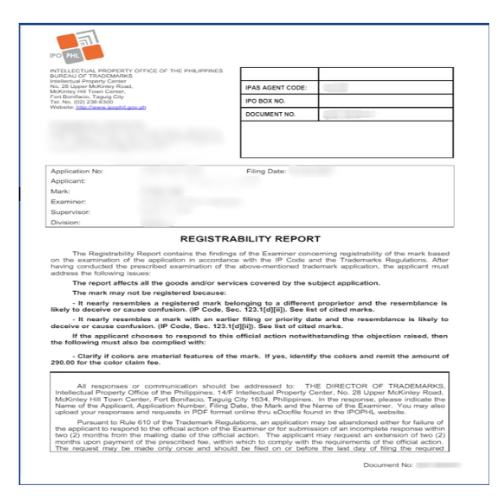Say, you have successfully submitted your trademark application to the Intellectual Property Office of the Philippines (IPOPHL), and you could no longer wait to tell the world that you have exclusive rights over your self-conceptualized and designed mark – until you received a Registrability Report. It says that there are issues with it. It’s upsetting.
Receiving a Registrability Report, however, is common, but it does not always mean that the mark can no longer be registered. Sometimes, there are just aspects of it that must be clarified. Sometimes, there are just minimal adjustments that must be made.
Read on and find out what this report is all about, its purpose and content, and how to properly respond to it. You may also leave your comments below or reach out to our legal experts and trademark specialists for additional information or assistance.
Registrability Report
A Registrability Report is the first Office Action (OA) that contains the findings of the Examiner concerning non-compliance or issues with the mark based on the examination of the application in accordance with the Intellectual Property Code of the Philippines and the Trademarks Regulations.
The applicant has to respond within two (2) months from the mailing date to the report and resolve the issue. If not resolved, a Subsequent Action (SA) will be served. It is another Office Action (OA) that contains the reiteration of the findings stated in the Registrability Report when the Examiner raises new issues, clarifications, or elaborations arising from the submitted response.
If there is no issue with the trademark application, however, a Notice of Allowance is received by the applicant. Unlike the report, it is a notification informing that the application has passed the criteria for registration, and after payment of the fees indicated therein, the mark will be published in the IPOPHL eGazette for purposes of possible opposition.
Parts of a Registrability Report
A Registrability Report may be a one-page document or may also come in multiple pages if there are attachments for the cited marks found after search and examination.
- Filing Reference Numbers. These include the Industrial Property Automation System (IPAS) Code, IPO Box Number, and Document Number.
- Applicants’ Information. The inside address of the report (i.e., in letter format) includes the applicant’s complete name, contact number, complete mailing address, and email address.
- Application Details. These include the application number, filing date, applicant’s identity, trademark for registration, assigned examiner, supervisor, and division.
- Examination Findings. This is the core element of the report, and it contains issues regarding the registrability of the mark, conflicts with or violations of the Intellectual Property Code of the Philippines and Trademarks Regulations, and further recommendations by the assigned Examiner.
- Cited Marks (Attachments). The second and succeeding pages, if any, contain information about other marks in conflict with the one being registered. These include the application numbers, filing dates, and owners or applicants for the said trademarks.
Sample Registrability Report
As previously mentioned, a Registrability Report is sent to the applicant if there is any issue with the mark being applied for registration as found by the Examiner, hence the content varies based on situations. It may also serve as a request for clarifications regarding the elements of the mark, offer suggestions, and provide options. In the given sample report below, the findings indicated read:
The report affects all the goods and/or services covered by the subject application. The mark may not be registered because:
- It nearly resembles a registered mark belonging to a different proprietor, and the resemblance is likely to deceive or cause confusion. (IP Code, Sec. 123.1[d][dd]). See list of cited marks.
- It nearly resembles a mark with an earlier filing or priority date and the resemblance is likely to deceive or cause confusion. (IP Code, Sec. 123.1[d][dd]). See list of cited marks.
If the applicant chooses to respond to this official action notwithstanding the objection raised, then the following must also be complied with:
Clarify if colors are material features of the mark. If yes, identify the colors and remit the amount of PHP290.00 for the color claim fee.

As can be understood from the findings, the IPOPHL refuses to proceed with the registration because the mark, after search and examination, has been found to be in violation of certain provisions in the Intellectual Property Code of the Philippines, i.e., it resembles an already registered mark and another mark with an earlier filing or priority date. However, the applicant is still given the prerogative to respond to the report and clarify things. At the same time, there is also a need to confirm the color elements of the mark, which are also subject to a color claim fee.
How to Respond to a Registrability Report
- Read the findings carefully. The core element of the report is the examination findings contained on the first page. Read carefully the indicated grounds for refusal of registration, recommendations, options, and further actions required, if any. Refer also to Section 123 of the IP Code for additional information about these grounds.
- Decide on further actions. Whether to respond or not depends on the situation. Simple issues (e.g., needs for clarifications, minimal adjustments to the mark, etc.) may be easily resolved by responding to the report. For more serious issues, however, such as the genericness of the mark, resemblances with existing trademarks, and other violations of the absolute grounds provided in the IP Code, serious decisions must also be made. In some cases, it may be more viable not to respond anymore and apply for registration of a new mark instead.
- Consult a legal expert or trademark specialist, if necessary. If the situation requires a legal intervention (e.g., the mark has long been part of the brand identity and rebranding may cost the business, resemblances with existing or registered trademarks can be justified and legally resolved, there is a trademark infringement involved, etc.), then it is always best to consult a lawyer or a trademark specialist for clarity and assistance.
- Draft the response letter. Acknowledge the issues raised in the Registrability Report and address them, one after another, in the response letter. Follow the formal and standard template and ensure that all details, from the heading down to the signature line, are accurate and complete. If already consulting a legal expert or trademark specialist, then drafting the response may also be part of their services.
- Submit the response within the prescribed period. The response letter may already be submitted online via the IPOPHL official website. It must be made within two (2) months from the mailing date. However, it may also be extended for another two (2) months upon request and payment of the required fees. If the issues are not resolved after responding to the report, expect another communication from the IPOPHL, the Subsequent Action (SA).
Trademark Registration Process
To further understand the purpose of the registrability report and the response needed from the applicant, read the trademark application process below.
- Submission of Application. Based on the circular, trademark applications are examined for registrability in the order in which the complete requirements for grant of a “filing date” are received by the IPOPHL. Priority of the examination, however, may be granted if petitioned under oath with payment of additional fees and upon approval by the assigned Examiner.
- Examination of Application. After successful submission of documentary requirements, the trademark application is assigned to an Examiner. As defined, an Examiner is a “Trademark Examiner or any official or employee of the Bureau of Trademarks authorized to examine applications for registration or renewals thereof.”
The assigned Examiner has the original jurisdiction over the examination of the application and over the respective allowance for publication in the IPOPHL eGazette for the purpose of opposition. The decision, when final, will be subject to a petition and appeal to the Director.
If, after the examination, the application is found not to be registrable for any reason, the applicant will be advised of the reason/s therefor, and will be given such information and references as may be helpful in the further prosecution of the application.
If during the examination of the application, the Office finds factual basis to reasonably doubt the veracity of any indication or element in the application, the Examiner may require the applicant to submit sufficient evidence to remove the doubt. This evidence may be in the form of a sworn statement of ownership and/or an affidavit of good faith, among others.
All Examiners are required to include all grounds of objection existing at the time of the issuance of the first office action.
Where the Examiner has determined that any portion of a mark contains unregistrable matter that must be disclaimed, the Examiner shall communicate the findings to the applicant in the office action. If the applicant fails to comply with the Examiner’s requirement for a disclaimer, the Examiner must make the requirement final if the application is in condition for a final action.
- Period of Response. After receipt of the Registrability Report, the applicant is given two (2) months (i.e., from the mailing date) to respond to the report. Such a response must be complete, address all the issues raised by the Examiner, and may be made with or without amendment or submission of additional representations. The period, however, may also be extended for another two (2) months upon request by the applicant and payment of the required fees.
- Re-examination of Application. After the response by the applicant, the application will be re-examined or reconsidered by the Examiner, and if the registration is again refused or formal requirements are insisted upon, but not stated to be final, the applicant may respond again.
- Final Action. On any subsequent re-examination or reconsideration, the Examiner may state that the refusal of the registration or the submission of or compliance with any requirements is final. Thus, the applicant’s recourse is limited to an appeal to the Director or to compliance with the requirements made by the Examiner.
- Publication in the IPOPHL eGazette. An application for registration is subject to opposition proceeding before the issuance of the Certificate of Registration. Thus, if after examination or re-examination of an application for registration, it should appear to the Examiner-in-Charge that the mark is registrable, it shall be published for a 30 days opposition in the IPOPHL eGazette. The Intellectual Property Office published it on e – gazette to give the public a chance to oppose our application. Third-party may oppose the application within 30 days in the gazette. If no one opposes, our Certificate of Registration will be in line for a signature.
- Issuance of Certificate of Registration. When no opposition is filed within thirty (30) days after the publication for opposition, the mark is deemed registered on the next calendar day following the expiration of the opposition period. In cases where a motion for extension of the period to file an opposition is granted by the Bureau of Legal Affairs, the mark is deemed registered the day following the expiration of the extension period.
The registration shall remain in force for ten (10) years, renewable for periods of ten (10) years. Provided, That the requisite Declaration of Actual Use (DAU) as provided for under these regulations has been filed.
- Republication, in case of settlement. In instances where the mark is the subject of a settlement or compromise agreement, and there is an amendment to the mark, its description, and/or specification, the amended mark may be republished for the public’s information.
Need further information and assistance regarding Trademark Registration? Talk to our team at Duran & Duran-Schulze Law in BGC, Metro Manila, Philippines to know more about the requirements and process. Call us today at (+632) 8478 5826 or +63 917 194 0482, or send an email to info@duranschulze.com for more information.




